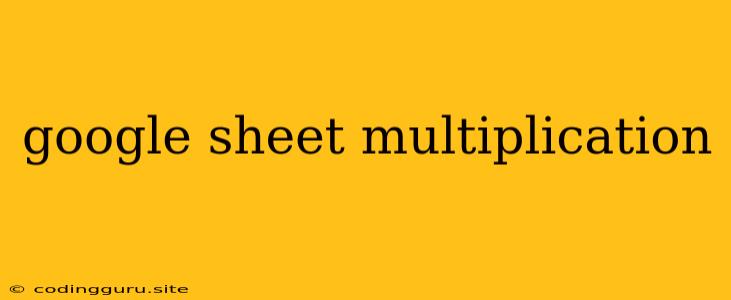Multiplying Numbers in Google Sheets: A Comprehensive Guide
Google Sheets is a powerful tool for organizing and analyzing data. One of the most fundamental operations you can perform is multiplication. This guide will walk you through various methods to multiply numbers in Google Sheets, catering to different scenarios and levels of complexity.
1. Basic Multiplication with the "*" Operator:
The most straightforward way to multiply numbers in Google Sheets is using the "*" operator. Simply type the following formula in a cell:
=A1 * B1
This formula will multiply the values in cells A1 and B1 and display the result in the cell where you entered the formula. You can replace A1 and B1 with any cell references you want to multiply.
2. Multiplying Entire Columns or Rows:
Sometimes, you might need to multiply an entire column or row of numbers by a constant value. This can be easily achieved using the following steps:
- Select the cell where you want the result to appear.
- Type the formula: =ArrayFormula(A1:A10 * 5) (Replace A1:A10 with your desired range and 5 with the constant value).
- Press Enter.
This formula will multiply each value in the specified range by the constant value and display the results in the corresponding rows.
3. Multiplication with References to Other Sheets:
If you have data spread across multiple sheets within the same Google Sheet, you can still perform multiplication. To multiply values from different sheets, follow these steps:
- Select the cell where you want the result to appear.
- Type the formula: ='Sheet2'!A1 * 'Sheet3'!B1 (Replace "Sheet2" and "Sheet3" with the actual sheet names and A1, B1 with the corresponding cell references).
- Press Enter.
This formula will fetch values from cells A1 in "Sheet2" and B1 in "Sheet3" and multiply them.
4. Multiplication Using the PRODUCT Function:
For more complex multiplication scenarios involving multiple values, the PRODUCT function comes in handy. This function multiplies all the values provided as arguments.
Example:
=PRODUCT(A1, B1, C1)
This formula will multiply the values in cells A1, B1, and C1.
5. Combining Multiplication with Other Functions:
You can integrate multiplication with other Google Sheet functions to perform more advanced calculations. For instance, you can combine multiplication with SUM, AVERAGE, or IF functions.
Example:
=SUM(A1:A10) * 5
This formula will first sum the values in cells A1 to A10 and then multiply the sum by 5.
6. Using Multiplication in Conditional Formatting:
You can use multiplication in conditional formatting to highlight cells that meet specific criteria. For instance, you can highlight cells where the product of two values is greater than a threshold.
Example:
- Select the range of cells you want to apply conditional formatting to.
- Go to Format > Conditional Formatting.
- Select "Custom formula is" under "Format cells if".
- Enter the formula: =A1 * B1 > 100 (Replace A1 and B1 with the cells you want to multiply and 100 with your threshold).
- Choose the desired formatting style.
This will highlight cells where the product of the values in A1 and B1 exceeds 100.
7. Multiplying Using Google Sheets' Spreadsheet Formula:
If you're using the Google Sheets spreadsheet formula, you can use the * operator directly to perform multiplication. For instance, to multiply A1 by B1, you would enter:
=A1 * B1
8. Multiplication Using the "SUMPRODUCT" Function:
The SUMPRODUCT function is very useful for performing multiplications on entire ranges of cells. It multiplies corresponding cells within the ranges and then sums up the results.
Example:
=SUMPRODUCT(A1:A5, B1:B5)
This formula will multiply each cell in the range A1:A5 with the corresponding cell in the range B1:B5, and then sum up all the products.
9. Dealing with Errors in Multiplication:
Sometimes, your multiplication formulas might encounter errors. For instance, if one of the cells contains text instead of a number, the formula might return an error. To prevent errors, you can use the IFERROR function.
Example:
=IFERROR(A1 * B1, 0)
This formula will multiply A1 and B1 if both cells contain numbers. If either cell contains text or an error, it will return 0.
10. Multiplying with Multiple Operators:
You can combine multiple multiplication operations within a single formula using parentheses to define the order of operations.
Example:
=(A1 * B1) * (C1 + D1)
This formula will first multiply A1 and B1, then add C1 and D1, and finally multiply the two results.
11. Multiplication in Google Sheets Charts:
You can incorporate multiplication in your Google Sheets charts to visually represent the results of your calculations.
Example:
- Create a chart based on your data.
- Right-click on the chart and select "Edit chart".
- In the "Chart editor", go to the "Customize" tab.
- Under "Series", click on the "Series" drop-down menu and select "Add series".
- In the "Series" section, select the cells that contain the result of your multiplication operation.
- Adjust the chart type and formatting as needed.
This will create a chart that includes your multiplication results as a separate series.
Conclusion:
Multiplying numbers in Google Sheets is a fundamental skill for data analysis and manipulation. This guide has covered various methods for multiplication, from basic operations to more complex scenarios. With these techniques, you can confidently perform multiplication tasks and enhance your data analysis capabilities in Google Sheets.
